service schedule CHEVROLET CAMARO SS 2010 Owners Manual
[x] Cancel search | Manufacturer: CHEVROLET, Model Year: 2010, Model line: CAMARO SS, Model: CHEVROLET CAMARO SS 2010Pages: 372, PDF Size: 1.91 MB
Page 2 of 372
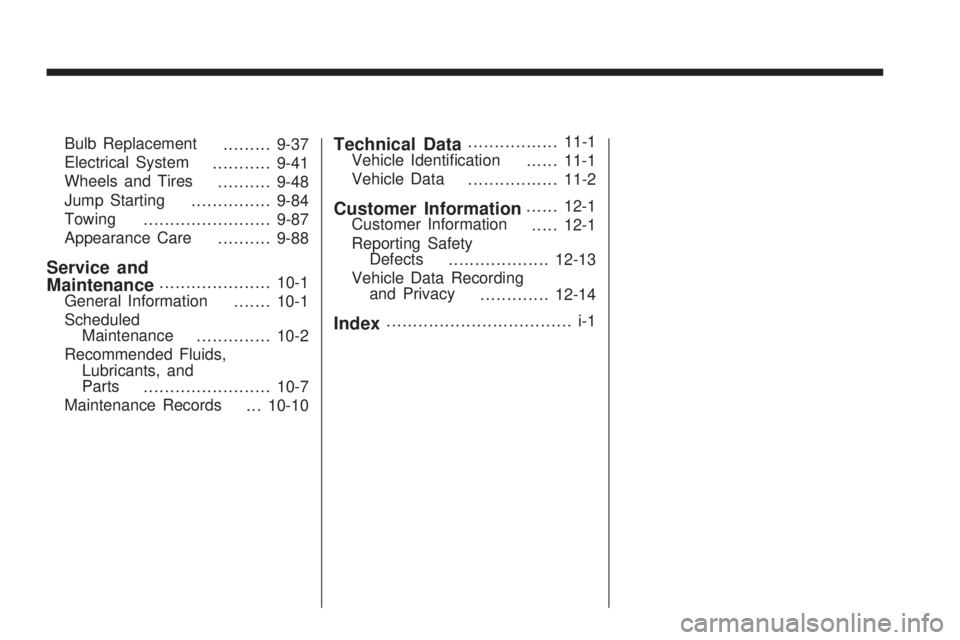
Bulb Replacement
.........9-37
Electrical System
...........9-41
Wheels and Tires
..........9-48
Jump Starting
...............9-84
Towing
........................9-87
Appearance Care
..........9-88
Service and
Maintenance.....................10-1
General Information
.......10-1
Scheduled
Maintenance
..............10-2
Recommended Fluids,
Lubricants, and
Parts
........................10-7
Maintenance Records
. . . 10-10
Technical Data.................11-1
Vehicle Identification
......11-1
Vehicle Data
.................11-2
Customer Information......12-1
Customer Information
.....12-1
Reporting Safety
Defects
...................12-13
Vehicle Data Recording
and Privacy
.............12-14
Index................................... i-1
Page 58 of 372

In addition, your dealer/retailer and
the service manual have information
about the location of the airbag
sensors, sensing and diagnostic
module and airbag wiring.
Airbag System Check
The airbag system does not need
regularly scheduled maintenance
or replacement. Make sure the
airbag readiness light is working.
SeeAirbag Readiness Light on
page 4-17for more information.
Notice:If an airbag covering is
damaged, opened, or broken, the
airbag may not work properly.
Do not open or break the airbag
coverings. If there are any opened
or broken airbag covers, have the
airbag covering and/or airbag
module replaced. For the location
of the airbag modules, seeWhat
Makes an Airbag Inflate? on
page 2-26. See your dealer/retailer
for service.
Replacing Airbag System
Parts After a Crash
{WARNING
A crash can damage the
airbag systems in your vehicle.
A damaged airbag system may not
work properly and may not protect
you and your passenger(s) in a
crash, resulting in serious injury or
even death. To help make sure
your airbag systems are working
properly after a crash, have them
inspected and any necessary
replacements made as soon as
possible.If an airbag inflates, you will need
to replace airbag system parts.
See your dealer/retailer for service.
If the airbag readiness light stays
on after the vehicle is started
or comes on when you are driving,
the airbag system may not work
properly. Have the vehicle serviced
right away. SeeAirbag Readiness
Light on page 4-17for more
information.
2-34 Seats and Restraints
Page 93 of 372
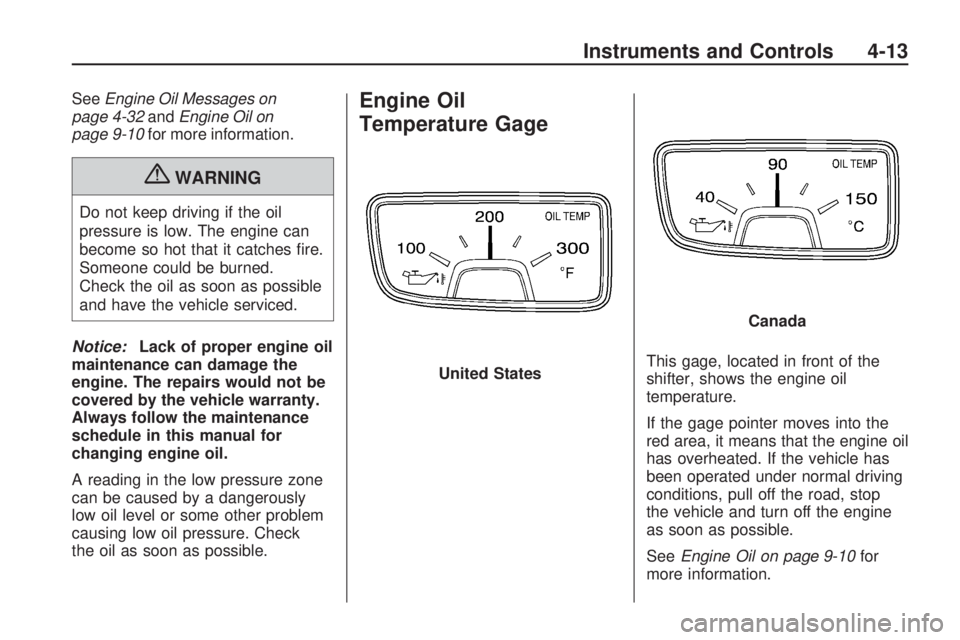
SeeEngine Oil Messages on
page 4-32andEngine Oil on
page 9-10for more information.
{WARNING
Do not keep driving if the oil
pressure is low. The engine can
become so hot that it catches fire.
Someone could be burned.
Check the oil as soon as possible
and have the vehicle serviced.
Notice:Lack of proper engine oil
maintenance can damage the
engine. The repairs would not be
covered by the vehicle warranty.
Always follow the maintenance
schedule in this manual for
changing engine oil.
A reading in the low pressure zone
can be caused by a dangerously
low oil level or some other problem
causing low oil pressure. Check
the oil as soon as possible.
Engine Oil
Temperature Gage
This gage, located in front of the
shifter, shows the engine oil
temperature.
If the gage pointer moves into the
red area, it means that the engine oil
has overheated. If the vehicle has
been operated under normal driving
conditions, pull off the road, stop
the vehicle and turn off the engine
as soon as possible.
SeeEngine Oil on page 9-10for
more information. United States
Canada
Instruments and Controls 4-13
Page 105 of 372
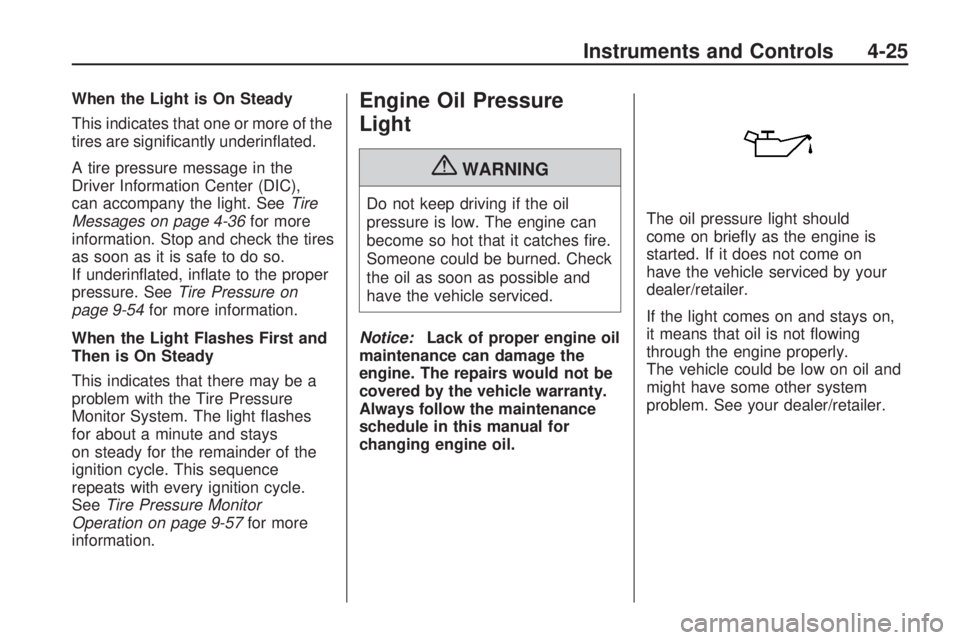
When the Light is On Steady
This indicates that one or more of the
tires are significantly underinflated.
A tire pressure message in the
Driver Information Center (DIC),
can accompany the light. SeeTire
Messages on page 4-36for more
information. Stop and check the tires
as soon as it is safe to do so.
If underinflated, inflate to the proper
pressure. SeeTire Pressure on
page 9-54for more information.
When the Light Flashes First and
Then is On Steady
This indicates that there may be a
problem with the Tire Pressure
Monitor System. The light flashes
for about a minute and stays
on steady for the remainder of the
ignition cycle. This sequence
repeats with every ignition cycle.
SeeTire Pressure Monitor
Operation on page 9-57for more
information.Engine Oil Pressure
Light
{WARNING
Do not keep driving if the oil
pressure is low. The engine can
become so hot that it catches fire.
Someone could be burned. Check
the oil as soon as possible and
have the vehicle serviced.
Notice:Lack of proper engine oil
maintenance can damage the
engine. The repairs would not be
covered by the vehicle warranty.
Always follow the maintenance
schedule in this manual for
changing engine oil.The oil pressure light should
come on briefly as the engine is
started. If it does not come on
have the vehicle serviced by your
dealer/retailer.
If the light comes on and stays on,
it means that oil is not flowing
through the engine properly.
The vehicle could be low on oil and
might have some other system
problem. See your dealer/retailer.
Instruments and Controls 4-25
Page 229 of 372

Maintenance When Trailer
Towing
The vehicle needs service more
often when pulling a trailer. See this
manual’s Maintenance Schedule or
Index for more information. Things
that are especially important in trailer
operation are automatic transmission
fluid, engine oil, axle lubricant, belts,
cooling system and brake system.
It is a good idea to inspect these
before and during the trip.
Check periodically to see that all
hitch nuts and bolts are tight.
Engine Cooling When Trailer
Towing
The cooling system may temporarily
overheat during severe operating
conditions. SeeEngine Overheating
on page 9-24.
Trailer Towing
Before pulling a trailer, there are
three important considerations that
have to do with weight:
•The weight of the trailer.
•The weight of the trailer tongue.
•The total weight on your
vehicle’s tires.
Weight of the Trailer
How heavy can a trailer safely be?
It should never weigh more than
1,000 lbs (454 kg). But even
that can be too heavy.
It depends on how the rig is used.
For example, speed, altitude, road
grades, outside temperature and
how much the vehicle is used to pull
a trailer are all important. It candepend on any special equipment
on the vehicle, and the amount of
tongue weight the vehicle can carry.
See “Weight of the Trailer Tongue”
later in this section for more
information.
Maximum trailer weight is calculated
assuming only the driver is in the tow
vehicle and it has all the required
trailering equipment. The weight
of additional optional equipment,
passengers and cargo in the tow
vehicle must be subtracted from
the maximum trailer weight.
Ask your dealer/retailer for our
trailering information or advice, or
you can write us at our Customer
Assistance Offices. SeeCustomer
Assistance Offices on page 12-3
for more information.
Driving and Operating 8-53
Page 246 of 372

What to Do with Used Oil
Used engine oil contains certain
elements that can be unhealthy for
your skin and could even cause
cancer. Do not let used oil stay on
your skin for very long. Clean your
skin and nails with soap and water,
or a good hand cleaner. Wash or
properly dispose of clothing or rags
containing used engine oil. See the
manufacturer’s warnings about the
use and disposal of oil products.
Used oil can be a threat to the
environment. If you change your own
oil, be sure to drain all the oil from the
filter before disposal. Never dispose
of oil by putting it in the trash, pouring
it on the ground, into sewers, or into
streams or bodies of water. Recycle
it by taking it to a place that collects
used oil.
Automatic Transmission
Fluid
How to Check Automatic
Transmission Fluid
It is not necessary to check
the transmission fluid level.
A transmission fluid leak is the
only reason for fluid loss. If a leak
occurs, take the vehicle to your
dealer/retailer service department
and have it repaired as soon as
possible.
There is a special procedure
for checking and changing the
transmission fluid. Because this
procedure is difficult, you should
have this done at your dealer/
retailer service department.Contact your dealer/retailer for
additional information or the
procedure can be found in the
service manual. To purchase a
service manual, seeService
Publications Ordering Information
on page 12-12.
Change the fluid and filter at the
intervals listed inScheduled
Maintenance on page 10-2, and
be sure to use the fluid listed
inRecommended Fluids and
Lubricants on page 10-7.
9-14 Vehicle Care
Page 248 of 372

Engine Air Cleaner/Filter
SeeEngine Compartment
Overview on page 9-6for the
location of the engine air
cleaner/filter.
When to Inspect the Engine
Air Cleaner/Filter
Inspect the air cleaner/filter at the
MaintenanceIIintervals and replace
it at the first oil change after each
50,000 mile (80 000 km) interval.
See “Schedule Maintenance” in
Service and Maintenance for more
information. If driving in dusty/dirty
conditions, inspect the filter at each
engine oil change.
How to Inspect the Engine Air
Cleaner/Filter
To inspect the air cleaner/filter,
remove the filter from the vehicle
and lightly shake the filter to release
loose dust and dirt. If the filter
remains caked with dirt, a new
filter is required.
To inspect or replace the engine air
cleaner/filter:
1. Open the hood. SeeHood on
page 9-5.
2. Locate the air filter housing
on the front of the driver
side of the engine compartment.
SeeEngine Compartment
Overview on page 9-6.
3.6 L V6 Engine Air Cleaner/
Filter Housing shown
(6.2 L V8 Engines similar)
9-16 Vehicle Care
Page 265 of 372
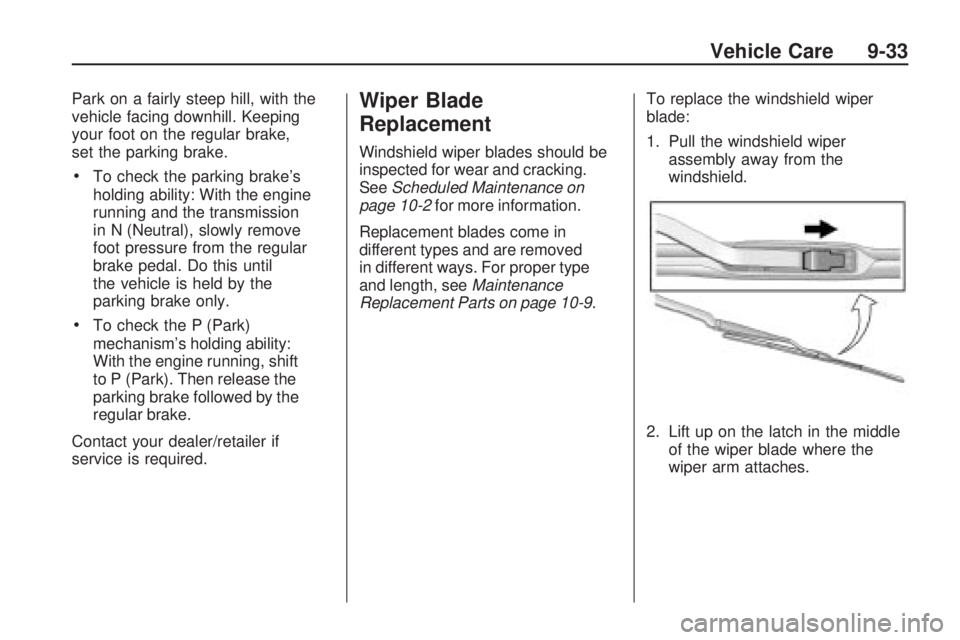
Park on a fairly steep hill, with the
vehicle facing downhill. Keeping
your foot on the regular brake,
set the parking brake.
•To check the parking brake’s
holding ability: With the engine
running and the transmission
in N (Neutral), slowly remove
foot pressure from the regular
brake pedal. Do this until
the vehicle is held by the
parking brake only.
•To check the P (Park)
mechanism’s holding ability:
With the engine running, shift
to P (Park). Then release the
parking brake followed by the
regular brake.
Contact your dealer/retailer if
service is required.
Wiper Blade
Replacement
Windshield wiper blades should be
inspected for wear and cracking.
SeeScheduled Maintenance on
page 10-2for more information.
Replacement blades come in
different types and are removed
in different ways. For proper type
and length, seeMaintenance
Replacement Parts on page 10-9.To replace the windshield wiper
blade:
1. Pull the windshield wiper
assembly away from the
windshield.
2. Lift up on the latch in the middle
of the wiper blade where the
wiper arm attaches.
Vehicle Care 9-33
Page 329 of 372

Service and
Maintenance
General InformationGeneral Information.............10-1
Scheduled MaintenanceScheduled Maintenance........10-2
Recommended Fluids,
Lubricants, and Parts
Recommended Fluids and
Lubricants.........................10-7
Maintenance Replacement
Parts................................10-9
Maintenance RecordsMaintenance Records.........10-10
General Information
Notice:Maintenance
intervals, checks, inspections,
recommended �uids, and
lubricants are necessary to
keep this vehicle in good
working condition. Damage
caused by failure to follow
scheduled maintenance might
not be covered by the vehicle
warranty.
Proper vehicle maintenance helps to
keep the vehicle in good working
condition, improves fuel economy,
and reduces vehicle emissions
for better air quality.
Because of all the different ways
people use vehicles, maintenance
needs vary. The vehicle might need
more frequent checks and services.
Please read the information under
Scheduled Maintenance. To keep
the vehicle in good condition, see
your dealer/retailer.The maintenance schedule is for
vehicles that:•carry passengers and cargo
within recommended limits on
the Tire and Loading Information
label. SeeVehicle Load Limits
on page 8-12.
•are driven on reasonable road
surfaces within legal driving
limits.
•use the recommended fuel.
SeeRecommended Fuel
on page 8-44.
{WARNING
Performing maintenance work can
be dangerous. Some jobs can
cause serious injury. Perform
maintenance work only if you
have the required know-how and
the proper tools and equipment.
If in doubt, see your dealer/retailer
to have a qualified technician do
the work. SeeDoing Your Own
Service Work on page 9-4.
Service and Maintenance 10-1
Page 330 of 372
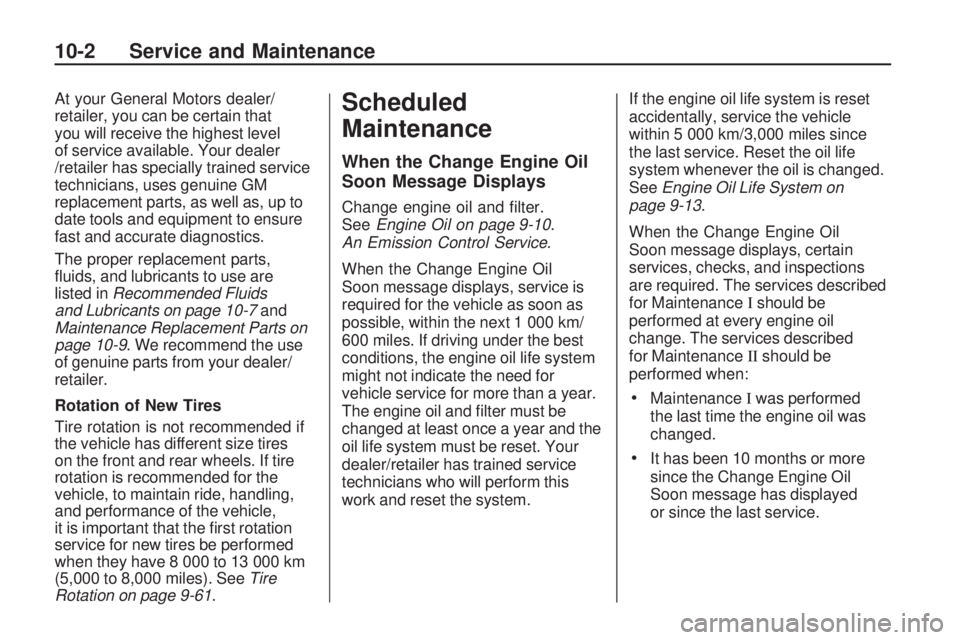
At your General Motors dealer/
retailer, you can be certain that
you will receive the highest level
of service available. Your dealer
/retailer has specially trained service
technicians, uses genuine GM
replacement parts, as well as, up to
date tools and equipment to ensure
fast and accurate diagnostics.
The proper replacement parts,
fluids, and lubricants to use are
listed inRecommended Fluids
and Lubricants on page 10-7and
Maintenance Replacement Parts on
page 10-9. We recommend the use
of genuine parts from your dealer/
retailer.
Rotation of New Tires
Tire rotation is not recommended if
the vehicle has different size tires
on the front and rear wheels. If tire
rotation is recommended for the
vehicle, to maintain ride, handling,
and performance of the vehicle,
it is important that the first rotation
service for new tires be performed
when they have 8 000 to 13 000 km
(5,000 to 8,000 miles). SeeTire
Rotation on page 9-61.Scheduled
Maintenance
When the Change Engine Oil
Soon Message Displays
Change engine oil and filter.
SeeEngine Oil on page 9-10.
An Emission Control Service.
When the Change Engine Oil
Soon message displays, service is
required for the vehicle as soon as
possible, within the next 1 000 km/
600 miles. If driving under the best
conditions, the engine oil life system
might not indicate the need for
vehicle service for more than a year.
The engine oil and filter must be
changed at least once a year and the
oil life system must be reset. Your
dealer/retailer has trained service
technicians who will perform this
work and reset the system.If the engine oil life system is reset
accidentally, service the vehicle
within 5 000 km/3,000 miles since
the last service. Reset the oil life
system whenever the oil is changed.
SeeEngine Oil Life System on
page 9-13.
When the Change Engine Oil
Soon message displays, certain
services, checks, and inspections
are required. The services described
for MaintenanceIshould be
performed at every engine oil
change. The services described
for MaintenanceIIshould be
performed when:
•MaintenanceIwas performed
the last time the engine oil was
changed.
•It has been 10 months or more
since the Change Engine Oil
Soon message has displayed
or since the last service.
10-2 Service and Maintenance